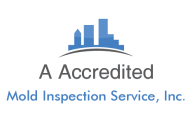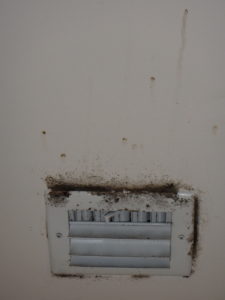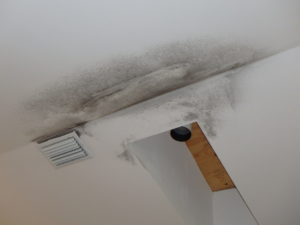Cladosporium Mold.
The above referenced Cladosporium is one of the most common groups of molds found growing both indoors and outdoors. According to Wikipedia there are 722 different species of Cladosporium. Some are plant pathogens, and others, on rare occasion cause infection in humans. As a mold inspector I am only going to discuss the common types of interest to you and me. I will discuss those typically found growing in and around the home. I will discuss the types most in need of cleaning and mold control measures.
The one thing I find most interesting about this very common household mold is that it very often grows in conditions not favorable to mold growth. It has taken a different route in it’s choice of environmental niches and food sources.
Most molds grow on substances that they can break down and eat. Most molds favorite foods are cellulose rich paper and wood. Molds will grow on these surfaces, release enzymes that break down the cellulose in the surface they grow on, and feed on the dissolved cellulose. However, unlike all other molds, Cladosporium mold will often grow on inorganic man-made surfaces that it cannot eat. It seems to feed on tiny amouts of dirt and dust on these surfaces.
Indoors it Commonly Grows on Nutrient Poor Surfaces Such As:
On the interior and exterior of metal, fiberglass, and plastic flex round ducts
Metal blower fans located inside AC units
Metal evaporator coils located inside AC units
Cold air handlers in humid attics where condensation forms.
Inside children’s wet bath toys
Marble window sills near cold windows where condensation forms.
Plastic window blinds where condensation forms.
Shower and bathroom tile and grout
Painted drywall where humid air touches colder surfaces
Under water damaged tile floors
In front end loaded washers
Outdoors Cladosporium Grows on Surfaces Like:
Plastic lawn furniture
Aluminum fences
Tile roofs
Stucco walls
Shady concrete sidewalks.
Abandoned boats
Abandoned cars
Plastic caps on car gas tanks
On live healthy leaves
When growing on the healthy leaves of trees and bushes it is commonly referred to as sooty mold. Though other molds may form sooty mold, it is often Cladosporium that causes this black soot like appearance on leaves.
Unlike other molds it will grow in full sun where it takes on a black coloration protects it from the sun. The black pigment might be melanin.
Do you see the pattern? Cladosporium thrives on surfaces that other molds cannot eat. How does it survive on such a Spartan diet?
1) Indoors it feeds not on the surfaces it grows on, but on the settled dust on those surfaces.
2) Outdoors it sometimes feeds on the honeydew excreted or pooped out by aphids and scale bugs. When this material settles on outdoor surfaces like leaves, the Cladosporium mold grows on the leaves and feeds on the honeydew.
Cladosporium on the authors metal fence. It is feeding on honeydew. Honeydew is previously eaten tree sap, that is pooped out by insects that are living in a nearby tree.
Further
The Problem With Cladosporium
As a full time Florida mold inspector, I find that Cladosporium is one of the most problematic molds because of it’s habit of hiding inside AC units. It hides out and grows in AC units and ducts for years undetected and often causes allergy and asthma type reactions in the home’s occupants for months or even years before the source is discovered and remediated. Despite it being an extremely common problem many inspectors overlook it because they do not know how to inspect AC ducts. They do not open AC units, or remove the filter, or smell the air coming out of ducts during inspections. Also, many homeowners ignore it because it cannot be seen. In addition, they ignore it because it is not toxic. But it is still a serious allergy related health issue that must be properly addressed if we are to breath healthy air.
The Best Way To Deal With Cladosporium Mold is to:
Cladosporium mold recommendations for the home.
- If it is more than a few square feet of growth call a mold remediator and have them remove it according to industry standards and guidelines.
- In some situations, homeowners take care of the mold themselves. Such situations would include instances where it is a small amount of mold on hard non-porous surfaces like shower tile and grout. This is also often the case when it is growing outdoors, such as on patios and patio furniture.
Cladosporium Mold Recommendations for the AC Unit and Ducts.
1) Have the interior of the ducts and the interior of the AC cleaned in accordance with NADCA standards. Before cleaning, it may be needed to have the AC and ducts inspected to verify if they are moldy and in need of cleaning.
2) Limit the introduction of food sources (dust) into the AC. Limit dust by using good filters, and seal openings in the AC enclosure so dust cannot bypass the filter.
3) Limit the introduction of needed moisture by setting the thermostat to auto and not to on.
4) Do not allow excess humidity into the property through open windows and doors when it is hot or humid outside.
5) Have the AC unit and ducts professional cleaned by a licensed AC cleaning firm. Work must be done in accordance with NADCA standards or similar acceptable and recognized and effective standards. Do not clean mold on the interior of any AC or ducts yourself, hire a professional.
Daryl Watters has a degree in Education for Teaching Biology and General Science and has had a lifelong interest in science and nature. He is the president of A Accredited Mold Inspection Service.
He is a Certified Indoor Environmental Consultant and a State Licensed Mold Assessor.
MRSA# 328.
If you are in need of a mold inspection in South Florida give us a call.
1888 381-6651










